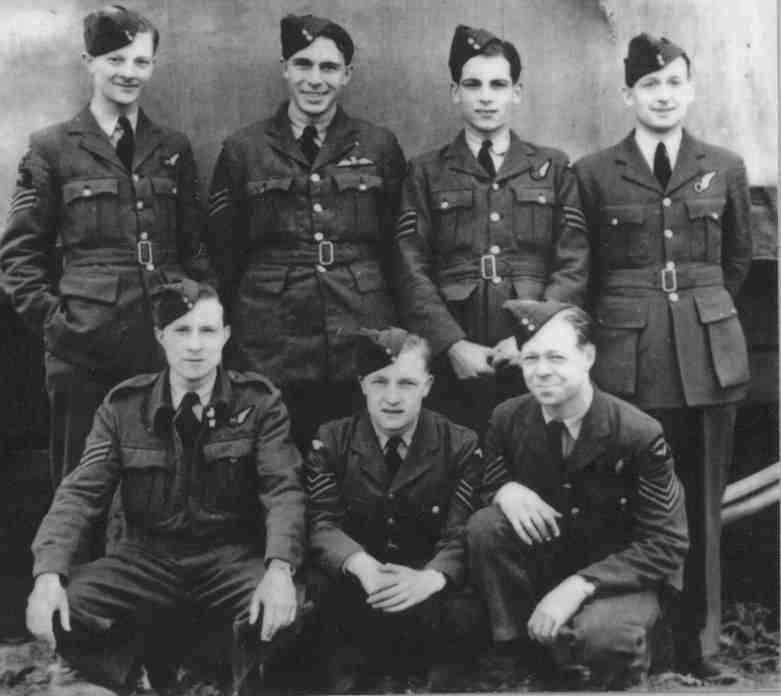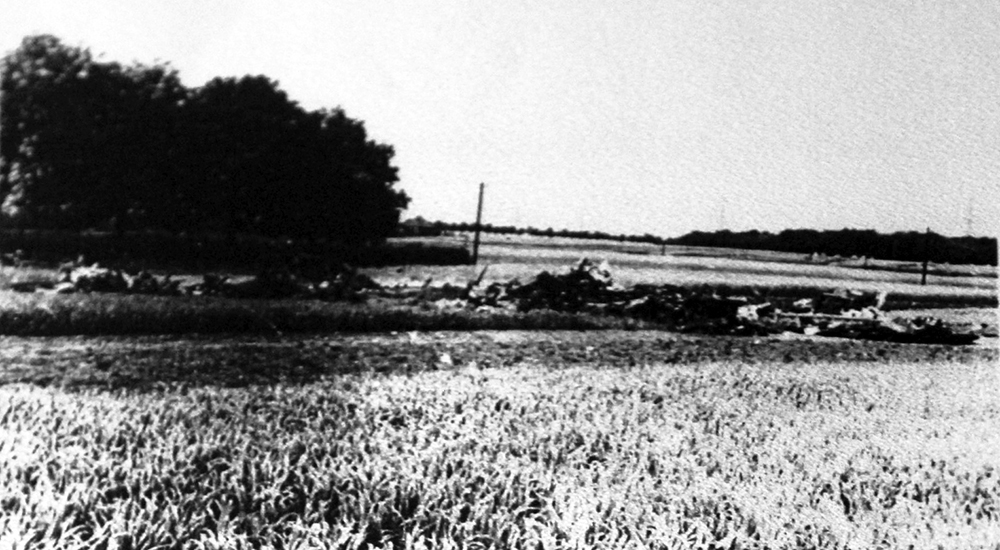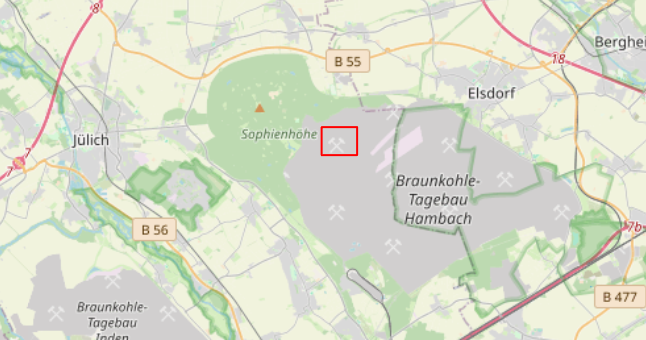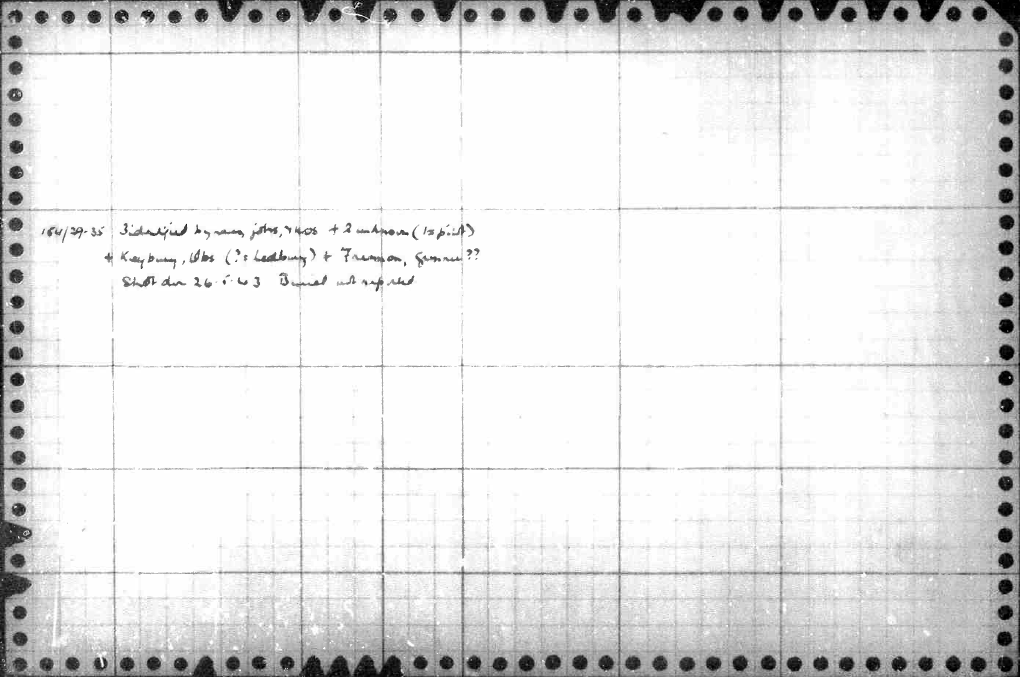25/26th May 1943




Aircrew

The Pilot, Sgt. Norman Collins (second from left, back row) a 22 year old Londoner was on his fifth mission. The only crew member not shown is Sgt. Bennett. He was a newly qualified pilot, and it was a requirement that new pilots had to accompany experienced crew on two bomber missions to observe and learn before being allowed to take their own crew on a real mission. Sgt. Bennett, on his first bombing mission, was the sole survivor, being hospitalised because of his injuries, and later becoming a Prisoner of War in Stalag Luft III (POW number unknown).
Aircraft
Stirling III, Serial No: EH887
The Stirling was the first British four-engined bomber of World War II. This Stirling III version was built by Austin Motors and delivered to RAF 218 Squadron on 20 May 1943. It bore the X1D (Identification) of HA-Z and was powered by Bristol Hercules engines.
The Stirling was very agile and praised for its ability to out-turn enemy night fighters and for its good handling characteristics, but its relative poor altitude ceiling was often a subject of criticism. When Stirlings were on operations with other RAF bombers which could fly higher, the Luftwaffe tended to concentrate on the Stirlings.
HA-Z had taken off at 00.16 on 26 May 1943 on a bombing mission to Düsseldorf, when it was shot down at 4300 metres (14,100ft), 8km east of Jülich by Major Walter Ehle of II./NJG1 at 01.55, and crashing 1km south of Steinstraß on the Jülich to Elsdorf road, killing 7 of the 8 crew. Steinstraß no longer exists, the site of the crash having been destroyed by the construction of the RWE-operated open-pit lignite mine, the largest man-made hole in Europe.

Walter Ehle's Abschußmeldung (Victory Claim Report) dated 28th May [20] states that EH887 was shot down in Planquadrant 61 1 3. The only possible location within that Planquadrat that fits the description given above is 61 1 3 9 i, the extent of the arbeit (the smallest map grid reference) being shown on the map below in red.
The aircraft appears to be located in the plains between the Grosse Forst and Escher Burge forests near the village of Winterbach, with the pylons of the main regional electricity supply faintly visible in the background.

The map below was published in 1944 by the British War Office showing locations of interest, and the arbeit boundaries from the map above superimposed in white. The route of the High Tension cables can be seen passing through the arbeit as a black line with Vs attached. (Map retrieved from the US National Archives)

Squadron
RAF 218 (Gold Coast) Squadron, based at Downham Market.
Luftgaukommando VI Münster Report
Whenever an allied aircraft crashed in Germany, or in German occupied territory, the scene was very quickly quarantined and the aircraft examined. A Luftgaukommando was an administrative command of the Luftwaffe responsible for air defence and support services. Luftgaukommando VI, based in Münster, was responsible for the area around Jülich. It published a report "Untersuchung von Nachrichtegërat in Abgeschossenes Feindflugzeugen" on 28th May 1943 covering the previous two nights' raids, detailing the electronic equipment that had been discovered in the crashed bombers [13]. A scan of the original report into EH887 is shown in German on the left, and the translation into English on the right
Untersuchung von Nachrichtegërat in Abgeschossenes Feindflugzeugen |
Investigation of Communication Devices in Downed Enemy Aircraft |
|---|---|

|
5.) Steinstrat: [Steinstraß, 8km east of Jülich] |
Loss Card
Bomber Command created a Loss Card [14] for each aircraft that failed to return from an operational flight. The data recorded on the cards normally includes the names of the crew, their fate, the route taken and bomb load. In some cases information from survivors has also been added, and post-war research regarding the crew and aircraft. The handwriting is notoriously difficult to decipher.

The front of the Loss Card for EH887 shows it was in Group 3, Squadron 218 and the planned route was 51 45N 03 50E to 50 55N 06 30E to Dusseldorf to 51 17N 06 30E to Noordwijk. The bomb load was 3 x 1000lb HE bombs, 7 x SBC x 4lb incendiary bombs and 9 x SBC X 20lb incendiary bombs. The aircraft was fitted with the TR1335 GEE navigational system.
The Loss Card shows a reference number followed by the numbers for each body found (whether identified or not). The reference is 154/29-35 where 29 = C.F Blanchard, 30 = J.C.Lamond, 31 = J.P.Roughan, 32 = W.J.Ledbury and 34 or 35 = N.S.Collins. The plane was burning fiercely as it crashed, making identification difficult.

The rear of the Loss Card reads:
154/29-35 3 identified by means of jobs & Nos + 2 unknown (1 = Pilot)
+ Krybury, Obs [Observer] (? = Ledbury) + Freemann, Gunner??
Shot down 26.5.43. Burial not reported
When aircraft were as badly damaged as EH887, bodies were often identified by the position in the aircraft the body was found, or details on the uniform such as the Observer's badge, or by personal items such as an initialled watch or cigarette case.
The German investigators searching the crash site were able to identify Blanchard, Lamond and Roughan together with their service numbers and the fact they were Observer, Air Gunner and Wireless Operator respectively. However, the service numbers of Fincham and Ledbury were obliterated and the bodies misidentified as 'Freemann' and 'Krybury'.
The German report indicates that they could not identify the other two bodies, other that one was known to be the pilot (M.S.Collins) but they were unable to determine his name.